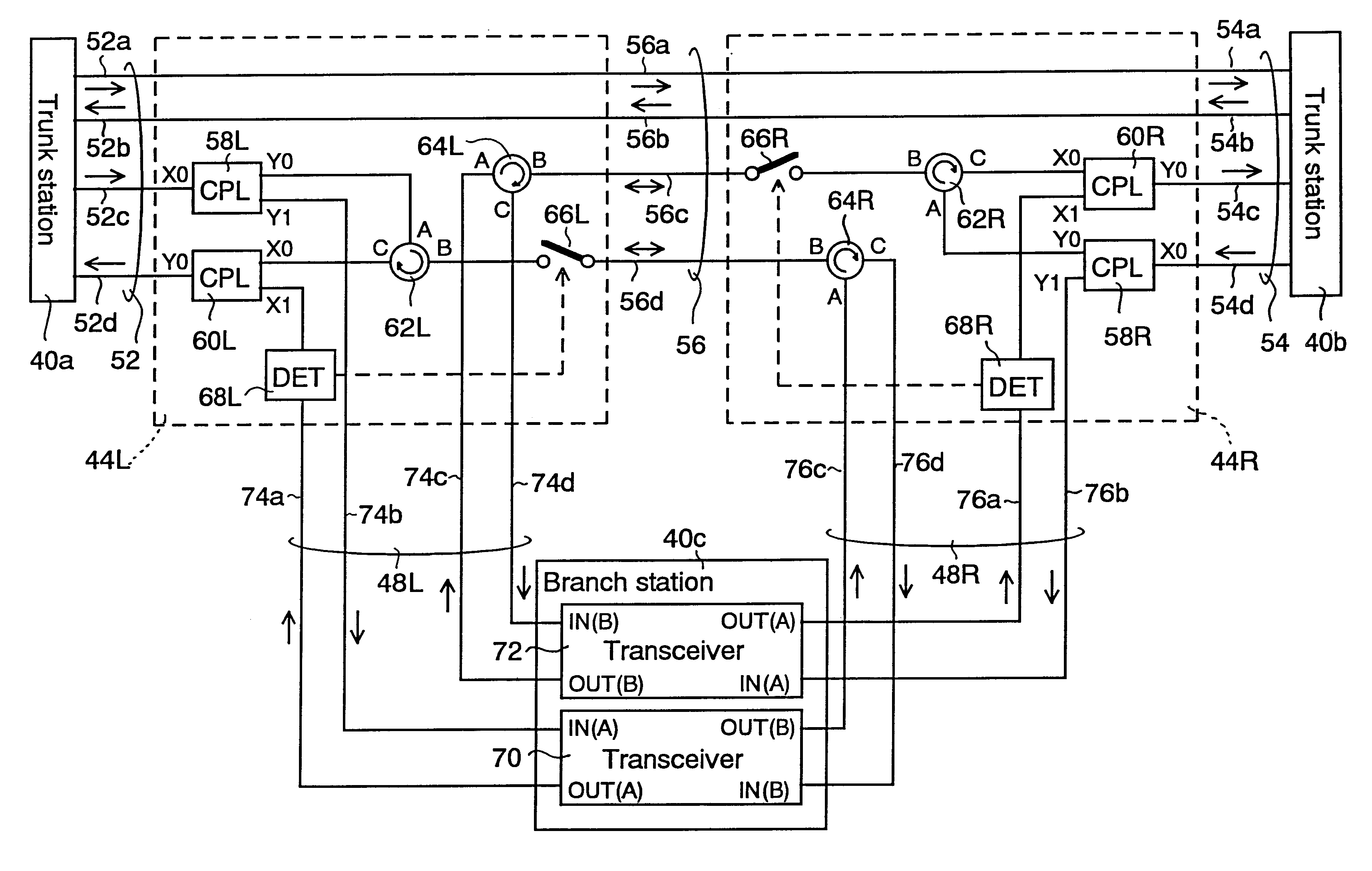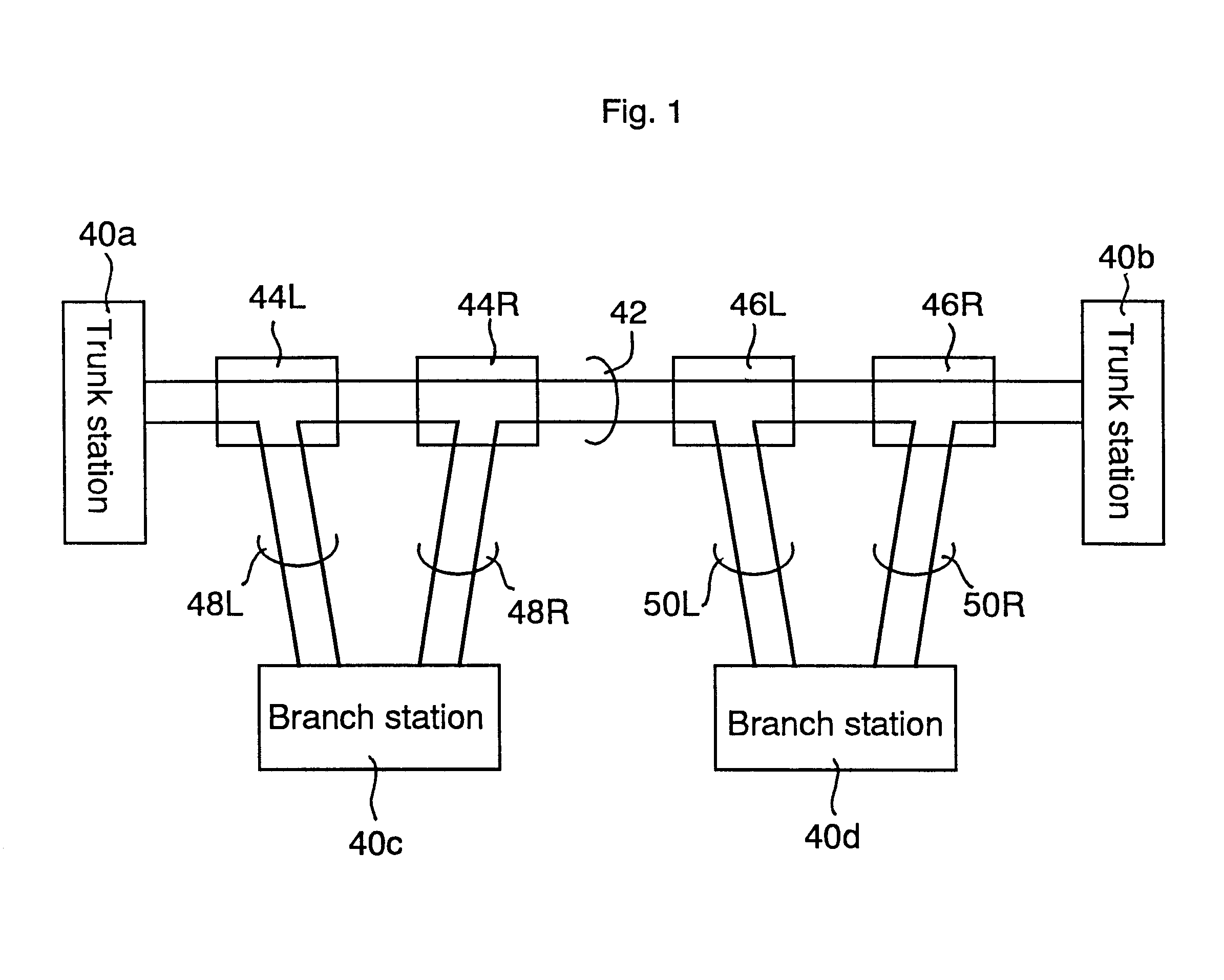Optical transmission system
a transmission system and optical transmission technology, applied in the field of optical transmission systems, can solve problems such as insufficient conventional construction
- Summary
- Abstract
- Description
- Claims
- Application Information
AI Technical Summary
Benefits of technology
Problems solved by technology
Method used
Image
Examples
first embodiment
FIG. 1 schematically shows the invention. A trunk cable 42 having two pairs of optical fibers is provided between trunk stations 40a, 40b. One of two pairs of the optical fibers is used for communication between the trunk stations 40a, 40b. The other of two pairs of the optical fibers is used for communication among the trunk stations 40a, 40b and branch stations 40c, 40d. Two branching units 44L, 44R; 46L, 46R are provided on the other pair for each branch station 40c, 40d, and are connected to the associated branch stations 40c, 40d by branching cables 48L, 48R, 50L, 50R.
That is, the branch station 40c is connected to the branching unit 44L by the branching cable 48L having two optical fiber pairs and to the branching unit 44R by the branching cable 48R having two optical fiber pairs. Depending on cases, two optical fiber pairs are used to connect the branching units 44L and 44R, or three (or more) optical fiber pairs are required. That will be explained later in greater detail.
Th...
second embodiment
the branching units 44L and 44R corresponding to FIG. 3(a) is explained below. FIG. 14 is a block diagram of its construction. Similarly to FIG. 4 et seq., the branching units 46L, 46R and the branch station 40d are omitted from illustration for easier understanding, and common elements to those of FIG. 4 are labeled with common reference numerals. Similarly to the embodiments explained with reference to FIGS. 11 to 13, optical signals may propagate in opposite directions in the normal condition (when normal lines are used) and in a troubled condition (when spare lines are used), and optical amplifying repeaters of an ordinary type cannot be inserted in the optical fibers 56c and 56d of the inter-unit connecting cable 56. However, optical amplifying repeaters of a bidirectional type can be inserted.
Each of the branching units 44L, 44R has an optical coupler (or optical divider) 102L, 102R having one input port X0 and two output ports Y0, Y1 to divide input light through the input po...
third embodiment
the branching units 44L, 44R corresponding to FIG. 3(a) is explained below. FIG. 17 is a block diagram schematically showing its construction. As shown in FIG. 17, here are used optical circulators 110L, 110R, 112L, 112R each having three ports A, B, C instead of the optical couplers 106L, 106R, 108L, 108L used in the embodiment of FIG. 14. The optical circulators 110L, 110R, 112L, 112R are optical elements for outputting input light at the port A from the port B and for outputting input light at the port B from the port C.
In FIG. 17, common elements as those in the embodiment of FIG. 14 are labeled with common reference numerals. Similarly to the embodiment shown in FIG. 14, no optical amplifying repeater can be inserted in the optical fibers 56c and 56d of the inter-unit connecting cable 56 because optical signals may propagate in opposite directions in the normal condition (when normal lines are used) and in a troubled condition (when spare lines are used). The embodiment shown h...
PUM
 Login to View More
Login to View More Abstract
Description
Claims
Application Information
 Login to View More
Login to View More - R&D
- Intellectual Property
- Life Sciences
- Materials
- Tech Scout
- Unparalleled Data Quality
- Higher Quality Content
- 60% Fewer Hallucinations
Browse by: Latest US Patents, China's latest patents, Technical Efficacy Thesaurus, Application Domain, Technology Topic, Popular Technical Reports.
© 2025 PatSnap. All rights reserved.Legal|Privacy policy|Modern Slavery Act Transparency Statement|Sitemap|About US| Contact US: help@patsnap.com



